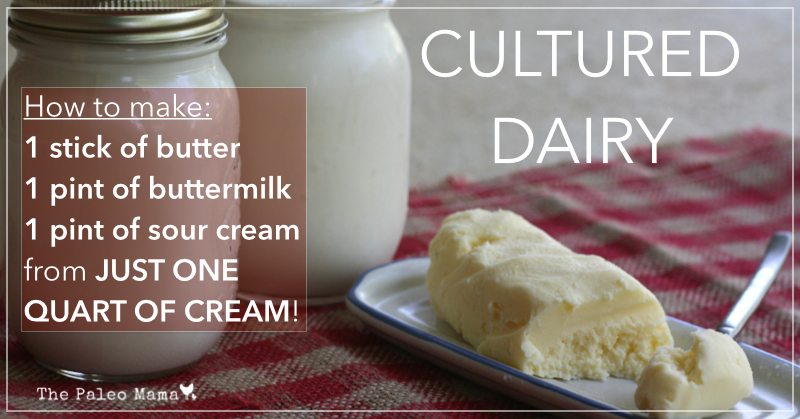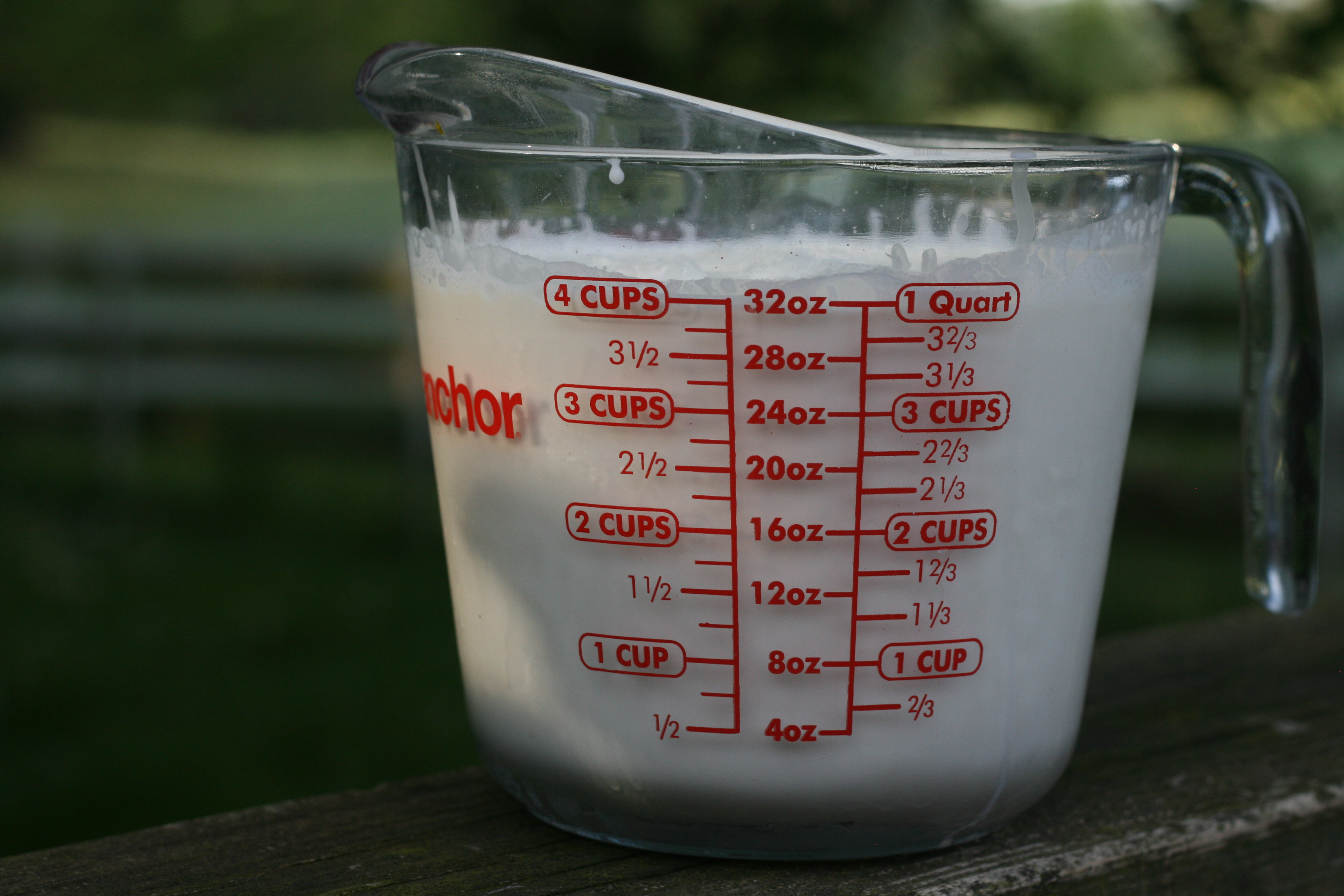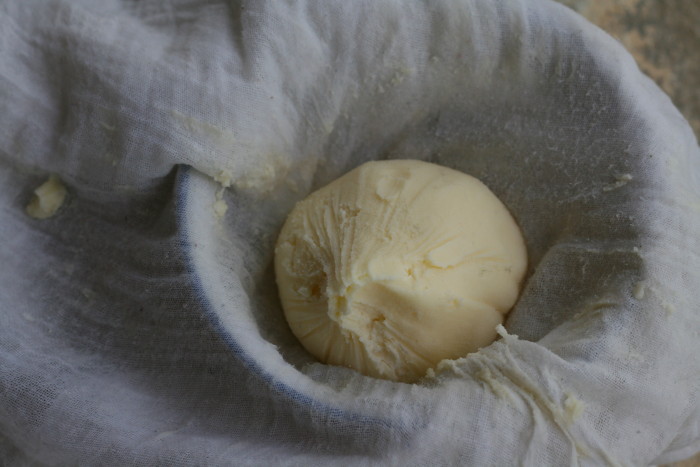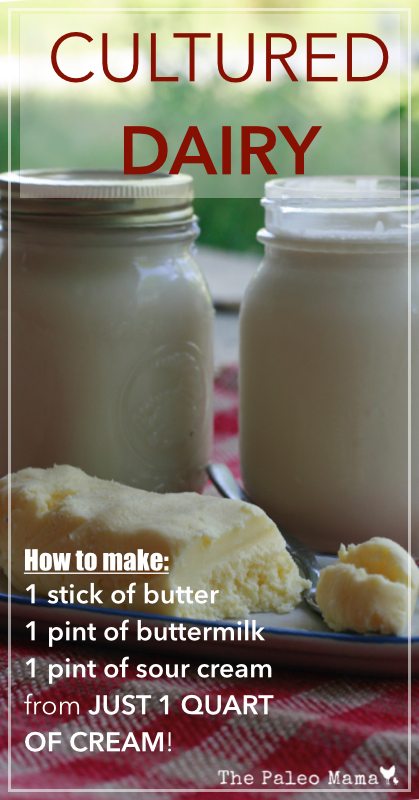

Before you go jumping down my throat about posting this because it’s dairy, I want to make sure I mention that my family consumes raw dairy. I have always been open about that and I feel it is something that my family thrives on.
So, am I still Paleo? I don’t really like labeling myself as anything. We eat by a Paleo template and include raw dairy in our diet. You can click here to see why my family consumes raw milk.
My goats are due to have babies in June, so the 2 months prior to birth, we are giving them a break from milking. It’s sad not to have fresh, raw goats milk everyday, but I am lucky to have lots of farms nearby that have raw milk. This past week I went with raw cow milk from Jersey’s….mostly cause raw goats milk is $12 a gallon! Yikes! I’ll just wait for my goats to kid in June!
Raw dairy is extremely nutritions, but cultured (fermented) dairy takes it to a whole new level. Culturing helps to break down casein, or milk proteins, one of the most difficult proteins to digest. It, also, restores enzymes that may have been destroyed during pasteurization including lactase, which helps to digest lactose (milk sugar) and numerous enzymes, which help the body absorb calcium and other minerals.
In addition, cultured dairy provides beneficial bacterial and lactic acid to help your digestive tract stay healthy. Click here to read all the benefits of raw cultured dairy.
Fun with Cultured Dairy:
How to Make 1 Stick of Butter, 1 Pint of Sour Cream, and 1 Pint of Buttermilk with JUST ONE Quart of Cream!
Tools Needed:
- Wooden Spoon
- Food Processor
- One Quart of Cream (preferably raw, but not necessary)
- 2 Pint sized mason jars
- One Cheesecloth (not necessary, you can use your hands)
Directions:
Step One: Culture Your Cream. Take your quart of cream and set it out on the counter for 8 hours to sour with the lid on.

Step Two: Make the Cultured Butter. Take one pint (2 cups) of the cream and pour it into your food processor. Set the other 2 cups aside. Turn your food processor on high and allow the blades to “churn” the cream into cultured butter. This takes roughly 10 minutes. When you start to see clumps forming in your cream, turn off your food processor and use your wooden spoon to push the butter to one side.

Scoop out the cultured butter and place it in a cheesecloth. Gently squeeze out all the cultured buttermilk back into the food processor bowl with the rest of the buttermilk.

Place the butter in a bowl with ice water and use your spoon to really push out any more buttermilk. Make sure to get as much excess liquid out. The ice water helps to firm up your butter. Remove the butter and use your hands to squeeze out any more water and form into whatever shape you would like. You have cultured butter!
Step Three: Make Your Buttermilk. Pour all your buttermilk leftover from making the butter into a pint-sized mason jar. You have cultured buttermilk!
Step Four: Make Your Sour Cream, aka Cream Fraiche’: Now take the other 2 cups of cultured cream that you set aside, and pour it into a pint-sized mason jar. Take one tablespoon of the cultured buttermilk that you made and put it inside the jar with the cream. Put the lid on and shake the jar to incorporate the cultured buttermilk with the cream.
Leave your jar on your counter or in a warm spot for 12 hours to culture even more and thicken. Chill well! You have European Style Sour Cream!
You will love this European Style Sour Cream that is also known as Creme Fraiche’. It is just like sour cream but much tastier. Put it on your potatoes, in your soup, on your eggs, and anywhere else you like to put sour cream. To make more Creme Fraiche’, follow Step Four above but use one tablespoon of leftover Creme Fraiche’, instead of cultured buttermilk, to culture another pint of cream! You can do this 6-8 times before you need to start over with cultured buttermilk!
I hope you have fun doing this! Let your kids help you and make it a fun kitchen experiment!

Hi Jackie! Can I ask what you use your buttermilk for? I’ve only ever used it in pancakes, and we don’t make those too often anymore!
Hey Emily! I use the buttermilk to make cultured smoothies! I just use it as the liquid base and make smoothies for us! It’s really good…a little tangy but kids and I both love it!
You can make Homemade Ranch dressing with it, too!
This is a very basic question, but we’re new to raw dairy. We can get raw milk from a local farm. How do we go from raw milk to cream? When we bring home our jar of milk, what comes next?
Hi Alicia! I guess I should have mentioned it in the post…good question. So, if skimmed the cream myself off a gallon of raw milk, I just let it sit and settle in the fridge for the night and in the morning I spooned off the cream layer on top. Lots of farmers sell the cream already separated, so you could ask them!
Hi Jackie! My family on the road to more whole, organic foods as much as possible. We use Paleo recipes a lot, because my girls and I have a hard time withe gluten. I’m wanting to transition to raw milk, because I really believe it’s better, and since my girls and I also suffer from lactose intolerance I’m really curious to try it, because I hear most people who have milk allergies can drink raw milk.
Anywho, when you say one quart of cream – how do you get/make the cream? Do you consider just the raw milk to be cream, or how can I turn raw milk into cream so I can use this recipe? I’m trying to make as much from scratch as possible. I love making my own yogurt.
Thanks!
Hey Amber! That all sounds great! For the cream, I skimmed it off a gallon of raw milk that I had just bought from a local farm. Lots of farmers sell cream already separated, so you could ask whoever you are buying it from! I hope that helps!
Just ask for ‘whole’ milk. Skimmed or low-fat by definition means that you want the cream skimmed off.
I can do this with pasteurized cream too? I don’t know where to get raw milk around here but I really would like to make this stuff sometimes. It would be economical for me to do it with a quart of heavy cream from the grocery store if it’s safe to do it with that.
I grew up on a farm and cannot digest pasteurized milk. But raw is fine. Makes me wonder what they do to such a perfect product. Here it is against the law to purchase raw milk or even use your own.
I *miss* my raw milk. We moved and cannot find any farmers around who do this. We eat Paleo(ish) and I can tell you that I totally agree that raw dairy is an entirely different thing to the stuff you get at a grocery store. When we had access we definitely drank it, made cheese with it, butter, etc.
Hello! I saw this post randomly from another “health” blog I follow and tried it yesterday. While it was successful and I am very excited about my butter, buttermilk, and creme fraiche, I did learn one valuable lesson. If you buy cheap cheesecloth, you will have a mess :). I bought some cheesecloth at the grocery store since I decided to do it last minute, and it was much more…..holey??….than yours. You could see right through it, no problem. Anyway, when I tried squeezing the butter, it just went through all of the holes like a strainer. I salvaged it with my hands luckily. Thanks!!
Oh I’m so sorry Elizabeth!!!
There is no need to apologize! I just thought my experience might be helpful for others if they choose to try it. Thank you so much for everything you do through this blog!!
Not sure where to find it, but look for butter muslin next time 🙂
I think folding the cheesecloth into layers so there’s fewer gaps between the holes might help this issue?
Iv had the same problem, I just use a few layers of the cheese cloth now.
Im wondering about the buttermilk. I thought buttermilk was different then what I read above. Not just the liquid left over from making butter, but something else entirely. Maybe Im confused;-) Which happens!
No buttermilk is the liquid left over from making butter!
i dont leave my cream sit before i make my butter. just pop it right into the processor.(gotta love that thing!!). i’ve used the buttermilk for pancakes and biscuits so far. your sour cream almost sounds like my yogurt. i just use the raw milk and heat it til there is a skin on it then let it cool and pour into qt jars. add a few tablespoons of store bought yogurt(or my own if there is any left), stir and then i let sit in the oven w/the light on for 12 hrs after barely heating it.(be sure to turn off your temp). then refrigerate. i havent tried adding any flavors yet though, we usually use it for strawberry banana smoothies anyway.:) great post. will try the sour cream. thank you.
Thanks for this post. We get raw dairy weekly, and I have been wanting to make butter, etc. I tried to make butter last week in the Vitamix and it did not work at all. I think the Vitamix heated up the cream too much. My question– how long will the creme fraiche, buttermilk, butter keep in the fridge after you make them? Thanks again!
Hi. I’d love to try with pasteurized cream (note, I have cream that is NOT ultra-pasteurized) and I have made creme fraiche using store-bought buttermilk. But I can leave pasteurized cream on the counter to simply culture? Won’t pasteurized cream spoil, not sour?
Please could you let me know how long the buttermilk can be kept in the fridge. Thanks for this post.
Althea
I believe up to a week or two.
I actually wonder when you say you use raw milk, do you boil it before you drink or use? or just consume raw? I make my own yogurt from organic whole milk, made some chese in the past, kefir etc… i”ll try this method if i can find raw cream…
No I donn’t boil it. We drink it raw.
I have a question. My butter and buttermilk turned out fine, but my creme fraiche did not seem to thicken at all. Is it supposed to be thick like sour cream you buy at the store? Mine seems to be the consistency of the original cream.
No, it’s supposed to thicken like sour cream. Hmmm…maybe you didn’t leave it out long enough.
YOU GOT a One Quart of Cream FROM ONE GaLLON OF MILK? I GET MaYBE a cup.
then what do you do with the resT OF THE MILK?
Thanks for this post! I just wanted to clarify… Are you saying that culturing restores enzymes in pasteurized milk? “It, also, restores enzymes that may have been destroyed during pasteurization including lactase, which helps to digest lactose (milk sugar) and numerous enzymes, which help the body absorb calcium and other minerals.”
I was wondering if you do this with your goat milk? A friend just turned me on to a source for raw goat milk. My family wouldn’t drink it, but I would love to make all of this with it.
Hi,
I was wondering if you could keep making buttermilk with this recipe, by adding milk to the original buttermilk and leaving it out for 24 hours? Or is it better to get a culture starter for that? Thanks so much for this post by the way!
Greetings from New Hampshire!
I have also had a lot of trouble with cheesecloth, but found a terrific fabric for straining cheese — the blue and white striped cleaning cloths you might find in a grocery store’s clean up section. In the USA a common brand is Handi Wipes, in Canada a common brand is J-cloth. Other brands work OK too, I use an off-brand myself. These cloths are 100 percent Rayon, don’t shed fibers on to your cheese, and don’t have added cleaning chemicals on them.
Some folks boil the cloth beforehand out of concern of removing any residual chemicals from the processing of the cloth, I don’t personally do this, but I do rinse the cloth before hand as a wet cloth is a bit easier to manage.
The cloths will last for a few batches of cheese, but eventually they will rip. I’ve found that right around the time the cloths get difficult to clean is right around the time they rip. If you have a few batches planned, its good to have extras on hand.
While Rayon is considered to be a “synthetic” fabric, it is actually made from plant fibers. These cloths compost VERY well!
Good luck everyone, and happy cheesemaking!
Have you done this with your goat milk? If so, how does it turn out?
No because it’s so hard to collect the cream from goat milk
I am interested in trying this out, however, the closest thing to raw milk that I have access to is non-homogenized VAT pasteurized milk. Should I start with a quart of heavy whipping cream? Since the cream I use will be pasteurized, do I need to expose it to the atmosphere before completing Step One: Culture Your Cream.
I have never done this with pasteurized milk but I believe it can be done the same way.
I have made all of these with my raw milk in the past. The ‘sour cream’ is DIVINE! I never thought to make the butter in my food processor! Great idea! I usually shake it in a mason jar (with the lid on of course) although my arm gets a little tired 🙂 I too have had the mess some of the others have mentioned using the ‘holey’ cheese cloth. It turned out a lot better just using a thin muslin dish towel. I hang it on my faucet for a while and it drains beautifully without getting everywhere. Yummy stuff! Love your blog!
I make my own butter all the time, but tonight is my first time making it from cultured cream. The cream is not churning into butter. I’ve had my mixer on high for a good half hour and it’s just a thicker cream. Thoughts?
Hmmm…I’m not too sure. I’m sorry! It works every time for me.
Don’t think you’d be able to do it with pasteurized milk… and wouldn’t want to, anyway – pasteurization kills ALL of the beneficial goodies in the milk!
How long does the sour cream last in the refrigerator?
About 5-7 days
Do you have to chill the cream after you culture it? I’ve read conflicting things on different blogs.
Yes, or it will continue to ferment and will only be good as a base for milk vodka.
You can do it in a mixer but it takes longer. A mason jar is quick, and so is a food processor. I use my mixer with a wisk attachment. The milk in the cold month has less rich cream, so it takes longer than in the spring because of the fresh green grass….just keep beating!
I had half a carton of heavy whipping cream in the fridge, and it smelled like it was going a little sour. Is it alright to use for butter and buttermilk? Also, how much salt do you add to the butter? Thanks!
I’d recommend you just get rid of it. No reason to take chances with it.
Is the “cream” the milk that comes straight from the goat? If not, How do you get cream from goats milk?
Here is a link that will give you directions for obtaining goat cream from goat milk. https://www.cuteness.com/article/make-cream-goats-milk